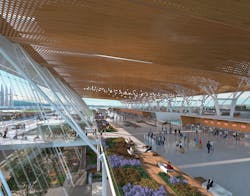The Evolution of Airport Design: Going Holistic, Going Net-Zero
As the fight against global climate change continues to dominate headlines, architects and designers have sought to make the aviation industry net-zero capable, one airport at a time. According to the International Air Transport Association (IATA), in 2018 alone, worldwide flights produced 895 million tons of carbon dioxide. Furthermore, humans produced over 42 billion tons of CO2 last year globally, and aviation was responsible for about two percent of these emissions. Compared to road transportation, which is responsible for 74% of CO2 emissions from all transport sources, aviation only accounts for 12 percent. However, at current rates of growth and pollution, an International Civil Aviation Organization (ICAO) estimate predicts that by 2050, the current figure is going to significantly rise by as much as 300 percent. Thus, the effort to create smart and environmentally conscious airport design goes on as airports worldwide assess their individual needs, alongside the challenges of constructing a fully sustainable facility.
Net Zero Building and Its Challenges
So what exactly does net zero mean? The U.S. The Department of Energy (DOE) defines a net zero building as an energy-efficient building where, on a source energy basis, the actual annual delivered energy is less than or equal to the on-site renewable exported energy. This definition also applies to other campuses, portfolios, and communities. Therefore, a net zero airport possesses renewable energy sources with a generation capacity that is equal to the airport’s total energy consumption, without the use of onsite combustion.
At present, many airports around the world are looking at how they can become net zero and carbon neutral. This is first and foremost a behavioral change and mindset. When proposing the idea of a net zero airport, one of the bigger challenges lies with the stakeholders. All stakeholders must be willing to commit to the decision, and the decision will likely require large sum investments to reconfigure the airport’s operations. In addition to utilizing different systems, staff would be required to undergo sessions of training to understand the new protocols and functions of a sustainable airport. Additionally, because there aren’t many airports that have applied net zero carbon neutral functions, stakeholders tread lightly when it comes to such changes. The second challenge with designing a net zero airport is devising a plan for a site in order to generate the amount of energy that will be needed for the entire airport. Whether the energy is generated by a solar powered field that is on-site, or not, there must be a site somewhere to offset the emissions. The same process would likely be required to reach the goal of becoming a carbon neutral building as well.
Terminal 2 at Guadalajara Airport (GDL): a Net-Zero Airport
At Guadalajara Airport (GDL) in Jalisco, Mexico, stakeholders called upon the expertise of architecture and design firm, CallisonRTKL (CRTKL), to build a new terminal from the ground up to develop the first net-zero airport in the world. With a population of 1.495 million people, Guadalajara is a bustling city with a need for an airport that can support tourism into Mexico, as well as serve as a focal point for connecting international travel. CRTKL was approached with this need, and was informed of how quickly the airport had outgrown its only terminal, Terminal 1, prompting the development of Terminal 2.
CRTKL envisioned an airport that not only integrates net-zero capabilities and the latest technologies for airport design, but a site that brings together the local folkloric music, dance, food, and symbols of the city, and also tells a tale of regionalism through a concept recognized as “The Soul of Guadalajara.” The inspiration for the terminal design is rooted in the flight of the Mexican Eagle—a longstanding emblem of power and prosperity for the country. Additionally, Mexico’s alluring and rich canyons, which are home to a variety of unique vegetation, provided inspiration for the lush, green elements throughout the interior of the terminal. Additionally, the new airport aims to surpass all current standards of excellence for domestic and international in Mexico. Designed with passenger comfort as the backbone, the airport is accessed by multiple points of entry. With soaring light-filled spaces in a parklike setting, the terminal incorporates the use of design elements that are largely modeled after the textures and colors of the vast, beautiful fields of agave, paying homage to this key ingredient in the production of tequila. In addition to interior design and exterior architecture, the client requested a parking structure that services both terminals, as well as landscape and roadway design.
In terms of energy consumption, a typical medium-sized airport terminal will have an Energy Use Intensity (EUI) of about 550 kWh/m2 year and would emit about 30,000 metric tons of carbon dioxide per year. After implementing multiple design strategies such as improved insulation, daylighting, canopy shading, economizer cooling, high performance mechanical HVAC, and improved lighting controls, Terminal 2 at GDL is targeted to reduce energy consumption to 170 kWh/m2 year. Renewable energy proposed on site will have the capacity to generate twenty million kWh every year and bring down the EUI to zero, making this a net zero energy and net zero carbon airport terminal. Additionally, CRTKL’s proposal for the new Guadalajara terminal will be designed to be carbon neutral for operation and emit 0 metric tons, which means that operating this terminal will be equivalent to planting 30,000 trees per year compared to other terminals. The proposal aims at looking into maximizing the use of low embodied carbon materials in the construction of the terminal.
Achieving Net Zero Through Holistic Design
Unique to CRTKL, holistic design is a hyperactive design process where all stakeholders come to the table during day one of planning. The traditional design approach encompasses one conceptual design plan that is then presented to the technical architects and consultants; mechanical, electrical, and plumbing (MEP); and stakeholders to ultimately agree or disagree with the plan. With holistic design, you have all the aforementioned parties involved at the table from the very beginning to collectively decide what direction to take with the entire airport’s design. This design process looks at a project in a different way, and has landscape architecture, interior design, environmental graphics, sustainability, and all its systems in complete harmony. Rather than designing the envelope of the building and then placing the structure in, holistic design looks at everything as a whole. All of these conversations happen at once, and all of its moving parts exist in unison.
COVID-19 and Airport Design
In early 2020, a global pandemic caused by the outbreak of the COVID-19 virus came and disrupted the aviation industry forever. For airports undergoing terminal design, maintenance, or construction, some blueprints needed to be scrapped or reevaluated to prepare for a population that now has heightened sensitivities toward cleanliness and safety. Since the outbreak, airports are trying to gain confidence by taking a look at the integration of a touch-free passenger experience, from curbside to aircraft. This encompasses ticketing, bag drop-off, TSA and customs, retail POS, and baggage claim without ever touching any surfaces through the use of static technology. With regard to the check-in process, airport technology is evolving to use facial recognition to seamlessly issue guests their ticketing and baggage. To account for COVID-19 regulations and temperature screening process, developers are looking into scans that simultaneously check for temperature and also metal detection. Additionally, in an effort to minimize the number of people at TSA and gates, airports are looking into issuing an appointment system which will place passengers in a queue and prompt a message to their smartphone device to notify them that their turn is coming up. Such processes will control how many guests are at the airport at any given time.
Health and wellness has always been a priority in terminal design, but now it must be infused into the DNA. The question now is, “How do we make this process seamless without making it obvious to the passenger?” Elements that were once fairly simple to incorporate in airport design have now become a challenge for designers, in order to comply with strict guidelines by the CDC. In addition to touchless check-in and security, touchless cleaning from curbside to airplane will impact every step of the traveler’s journey. Architects and designers are thinking about which materials can be used in airport design to clean and sterilize. Copper, for example, is a material that self-sterilizes, and while it is expensive, development of materiality will start to work toward a new government surrounding clean surface strategies.
First Net-Zero Airport and Beyond
As the first net-zero airport in the world, GDL is pushing the boundaries of sustainable airport design through seamlessly merging local culture and identity with innovative technology and developments. With many challenges along the way, from stakeholder uncertainty to planning and logistics, the outcomes of this net-zero airport will help the CallisonRTKL’s evolving aviation practice take strides toward the goal of net-zero for most, if not all airports. Through their signature holistic design approach, CallisonRTKL has successfully created an airport that is of the region, the city and the community at large.
Kapil Malik, FAIA, is an award-winning architect and designer whose work has been featured in a wide range of architectural journals and publications around the globe. Maintaining a delicate balance between global sophistication and local response, his work has simultaneously enhanced, defined and blurred the lines between a range of building typologies, including hospitality, mixed-use, airports and transportation. He believes in the potential of projects to become catalytic, not only for the communities in which they reside, but as models for sustainable architecture.





